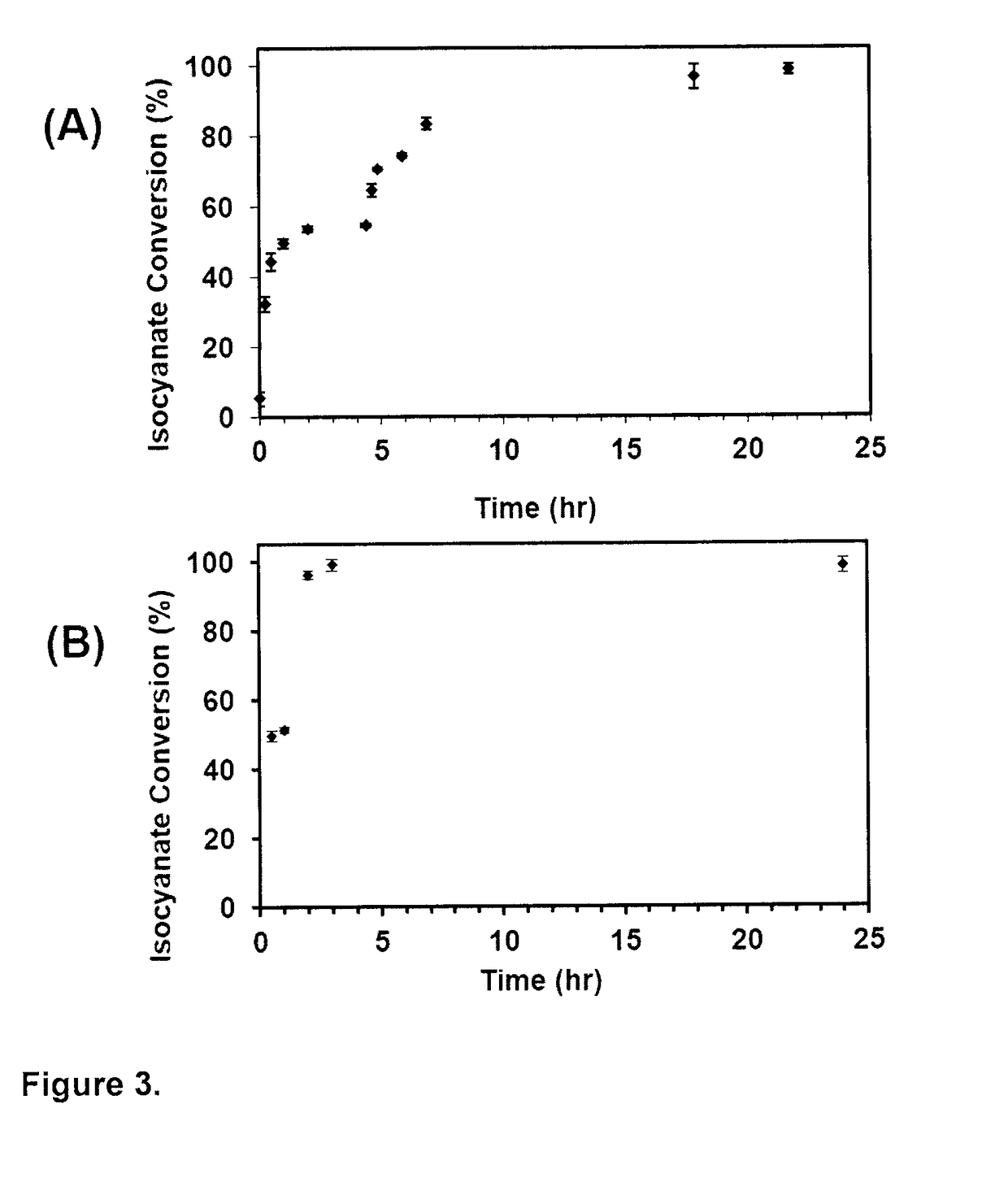Soft tissue filler
a soft tissue and filler technology, applied in the field of soft tissue fillers, can solve the problems of natural materials having problems with sourcing, control and consistency of materials, pre-sizing of shaped implants, and not having the flexibility provided by other fillers, and the use of patients' own tissue can complicate surgical procedures
- Summary
- Abstract
- Description
- Claims
- Application Information
AI Technical Summary
Benefits of technology
Problems solved by technology
Method used
Image
Examples
example a
ry Study
A.1 Materials
[0119]Anhydrous N,N-dimethylacetamide, benzoyl peroxide (BPO), dibutyltin dilaurate (DBDL), methyl methacrylate (MMA), methacrylic acid (MAA) and sodium bicarbonate (salt, 95 wt % of particles were in the range of 105-420 μm) were purchased from Sigma-Aldrich Canada and used as received. Diethyl ether (Fisher Scientific Canada) and polyethylene glycol (PEG, Polysciences Inc.) were used as received. Lysine diisocyanate (Arking Pharma, Canada) and 2-hydroxyethyl methacrylate (HEMA, Sigma-Aldrich Canada) were distilled under vacuum (0.05 mmHg) at 120° C. and 60° C., respectively to remove residual moisture, low-molecular weight impurities and partially polymerized reagents from the monomers prior to use. Poly (hexamethylene carbonate) diol (Average Mn=1006.278 g / mol, UBE America) was degassed under vacuum at 50° C. overnight prior to use.
A.2. Carbonate-Based Divinyl Oligomer Synthesis
[0120]Carbonate-based divinyl oligomer (C-DVO) was synthesized using LDI, PCN and ...
example 1
of Soft Tissue Fillers
1.1 Materials
[0132]Anhydrous N,N-dimethylacetamide, benzoyl peroxide (BPO), dibutyltin dilaurate (DBDL), methyl methacrylate (MMA), methacrylic acid (MAA) and sodium bicarbonate (salt, 95 wt % of particles are in the range of 105-420 μm) were purchased from Sigma-Aldrich Canada and used as received. Diethyl ether (Fisher Scientific Canada) and polyethylene glycol (PEG, Polysciences Inc.) were used as received. Lysine diisocyanate (Arking Pharma, Canada) and 2-hydroxyethyl methacrylate (HEMA, Sigma-Aldrich Canada) were distilled under vacuum (0.05 mmHg) at 120° C. and 60° C., respectively to remove residual moisture, low-molecular weight impurities and partially polymerized reagents from the monomers prior to use. Poly (hexamethylene carbonate) diol (Average Mn=1006.278 g / mol, UBE America) was degassed under vacuum at 50° C. overnight prior to use. Polyethylene glycol (PEG, 1000 Da, Sigma-Aldrich Canada) was degassed under vacuum at 50° C. for 48 h prior to use....
example 2
ization of Soft Tissue Fillers
2.1 Amino-Acid Derived Biodegradable Polycarbonate-Urethane Porous Scaffold Characterization
[0140]In the current study, while maintaining a constant total DVO molar ratio with respect to MAA and MMA monomers (1:5.5:15.5), the C-DVO was replaced with increasing concentrations (0, 10, 25 and 50 mol %) of E-DVO in the presence of a total porogen content of 75 wt % and 80 wt %. The extent of polymerization for the resulting 8 formulations was assessed. Specifically, based on gel fraction analysis, a gel content of approximately 90% was measured for all 8 formulations demonstrating no statistically significant difference in polymerization conversion (Table 2).
TABLE 2Gel content for porous amino-acid derived biodegradablepolycarbonate-urethane scaffolds. Data are mean ±standard deviation (n = 6).Gel Content (%)ScaffoldPorogenPorogenFormulationContent = 75 wt %Content = 80 wt %AAd-DPCU-E089 ± 292 ± 1AAd-DPCU-E1089 ± 292 ± 1AAd-DPCU-E2587 ± 292 ± 0AAd-DPCU-E508...
PUM
| Property | Measurement | Unit |
|---|---|---|
| porosity | aaaaa | aaaaa |
| compressive moduli | aaaaa | aaaaa |
| compressive moduli | aaaaa | aaaaa |
Abstract
Description
Claims
Application Information
 Login to View More
Login to View More - R&D
- Intellectual Property
- Life Sciences
- Materials
- Tech Scout
- Unparalleled Data Quality
- Higher Quality Content
- 60% Fewer Hallucinations
Browse by: Latest US Patents, China's latest patents, Technical Efficacy Thesaurus, Application Domain, Technology Topic, Popular Technical Reports.
© 2025 PatSnap. All rights reserved.Legal|Privacy policy|Modern Slavery Act Transparency Statement|Sitemap|About US| Contact US: help@patsnap.com



